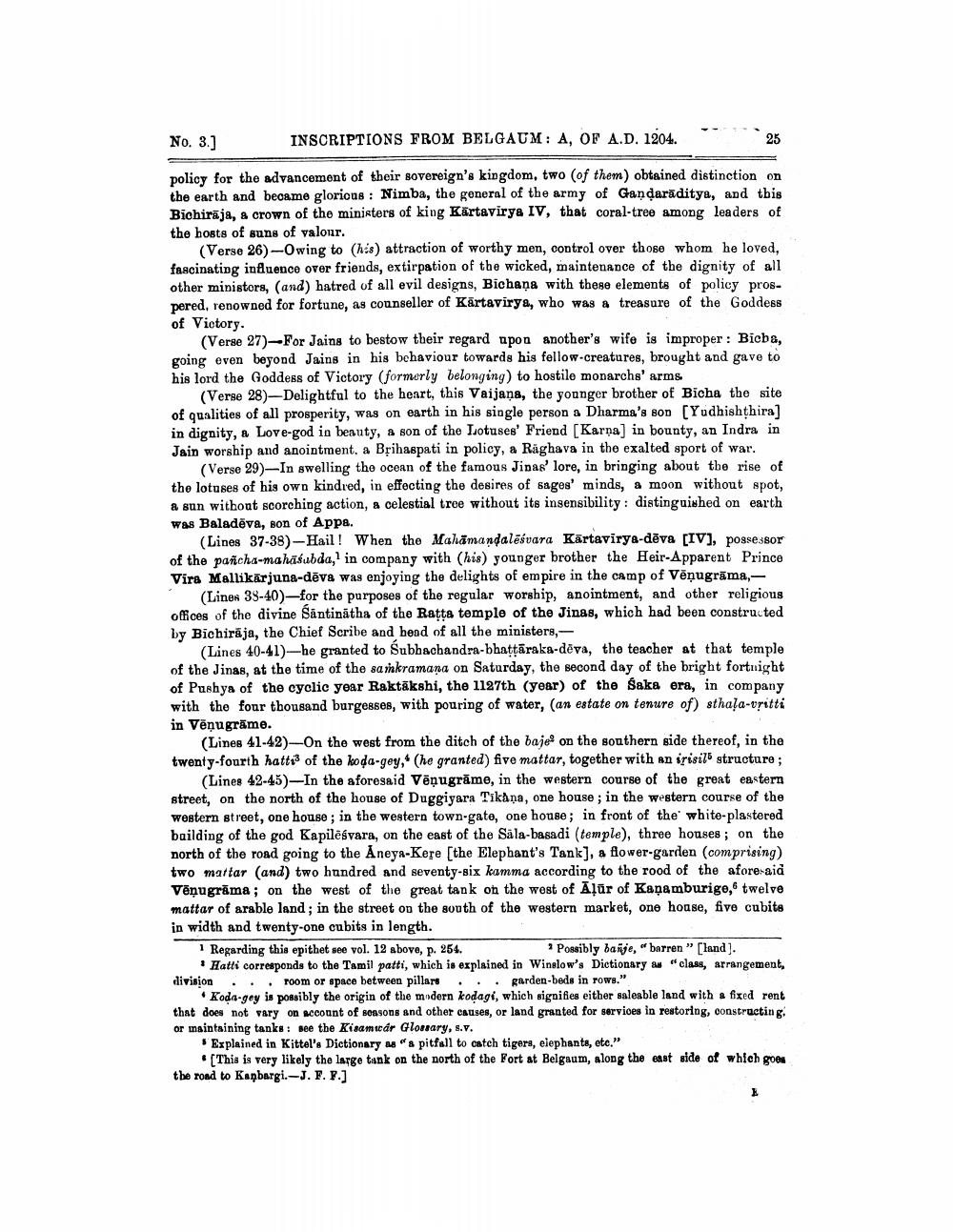________________
No. 3.]
INSCRIPTIONS FROM BELGAUM: A, OF A.D. 1204.
25
policy for the advancement of their sovereign's kingdom, two of them) obtained distinction on the earth and becamo glorious : Nimba, the general of the army of Gandaraditya, and this Bichirāja, a crown of the ministers of king Kärtavirya IV, that coral-tree among leaders of the hosts of suns of valonr.
(Verse 26)-Owing to (his) attraction of worthy men, control over those whom he loved, fascinating influence over friends, extirpation of the wicked, maintenance of the dignity of all other ministors, (and) hatred of all evil designs, Bichana with these elements of policy prospered, renowned for fortune, as counseller of Kārtavirya, who was a treasure of the Goddess of Victory.
(Verse 27)-For Jains to bestow their regard upon another's wife is improper : Bicba, going even beyond Jains in his behaviour towards his fellow-creatures, brought and gave to his lord the Goddess of Victory (formerly belonging) to hostile monarchs' arms
(Verse 28) Delightful to the heart, this Vaijana, the younger brother of Bicha the site of qualities of all prosperity, was on earth in his single person a Dharma's son [Yudhishthira] in dignity, a Love-god in beauty, a son of the Lotuses' Friend [Karna) in bounty, an Indra in Jain worship and anointment, a Bțihaspati in policy, a Rāghava in the exalted sport of war.
(Verse 29)- In swelling the ocean of the famous Jinab' lore, in bringing about the rise of the lotuses of his own kindred, in effecting the desires of sages' minds, a moon without spot, a sun without scorching action, a celestial tree without its insensibility : distinguished on earth Was Baladēva, son of Appa.
(Lines 37-38)-Hail! When the Mahamandalēsvara Kärtavirya-dēva (IV), possessor of the pancha-mahafubda,' in company with (his) younger brother the Heir-Apparent Prince Vira Mallikarjuna-dēva was enjoying the delights of empire in the camp of Vēņugrāma,
(Linen 39-40)—for the purposes of the regular worship, anointment, and other religious offices of the divine Säntinātha of the Ratta temple of the Jinas, which had been constructed by Bichirija, the Chief Scribe and head of all the ministers,
(Lines 40-41)-he granted to Subhachandra-bhattāraka-deva, the teacher at that temple of the Jinas, at the time of the samkramana on Saturday, the second day of the bright fortnight of Pushya of the cyclic year Raktākshi, the 1127th (year) of the Saka ora, in company with the four thousand burgesses, with pouring of water, (an estate on tenure of) sthaļa-vritti in Vēņugrāme.
(Lines 41-42)-On the west from the ditch of the baje' on the southern side thereof, in the twenty-fourth hatts of the koda-gey,' (he granted) five mattar, together with an irisilo structure;
(Lines 42-45)-In the aforesaid Vēņugrāme, in the western course of the great eastern street, on the north of the house of Duggiyara Tikana, one house; in the western course of the western street, one house; in the western town-gate, one house; in front of the white-plastered bailding of the god Kapilēšvara, on the east of the Sala-basadi (temple), three houses ; on the north of the road going to the Aneya-Kere (the Elephant's Tank], a flower garden (comprising) two mattar (and) two hundred and seventy-six kamma according to the rood of the aforesaid Vēnu grāma; on the west of the great tank on the west of Alur of Kaņamburige, twelve mattar of arable land; in the street on the south of the western market, one house, five cubite in width and twenty-one cubits in length. Regarding this epithet see vol. 12 above, p. 254.
Possibly banje,"barren" (land). Hatti corresponds to the Tamil patti, which is explained in Winslow's Dictionarys "class, arrangement, division . .. room or space between pillars . . . garden-beds in rows."
• Koda.goy is possibly the origin of the modern kodagi, which signifies either saleable land with a fixed rent that does not vary on account of seasons and other causes, or land granted for services in restoring, constructing or inaintaining tanks: see the Kisamicár Glossary, s.v.
Explained in Kittel's Dictionary as "& pitfall to catch tigers, elephants, etc."
(This is very likely the large tank on the north of the Fort at Belgaum, along the east side of which goes the road to Kanbargi.-J. F. P.]




